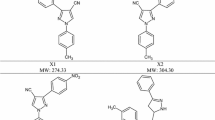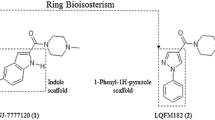Abstract
Inflammation is being a protective mechanism of the body towards the injury. However, chronic and progressive inflammation may lead to some chronic diseases. Due to the serious unwanted effects associated with available drugs, new and safe anti-inflammatory agents are still required. Therefore, the present study was designed to investigate the anti-inflammatory, analgesics, and antipyretic properties of a new compound (4-benzylpiperidine-1-carbodithioato-κ2S,S′)(1,4-bis-(diphenylphosphino)butane)palladium(II)chloride monohydrate (compound-1) in albino mice models. Compound-1 was characterized by elemental analysis, FT-IR, and multinuclear NMR spectroscopy. Initially, compound-1 was evaluated for cytotoxicity, anti-inflammatory, and analgesic activities by performing MTT assay, carrageenan-, histamine-, serotonin-, and CFA-induced paw edema, mechanical hyperalgesia, thermal hyperalgesia, and mechanical allodynia (0.1, 1, and 10 mg/kg, b.w). Antipyretic activity was evaluated in brewer’s yeast–induced model. The pro-inflammatory cytokines were measured by using commercially available ELISA kits. Additionally, nitrite production, antioxidant enzymes, H&E staining, muscle activity and motor coordination, and kidney and liver function tests were also determined. The results demonstrated that compound-1 significantly inhibited inflammation, pain, and febrile responses in all models at a dose of 10 mg/kg without effecting viability of cells in vitro at concentrations up to 100 μM. Similarly, the data clearly demonstrated significant reduction in the pro-inflammatory cytokines and nitrite production while enhancing antioxidant enzymes. Furthermore, pretreatment with compound-1 did not produce any prominent side effect on kidney, liver, stomach, and muscles. These findings suggest that compound-1 has potent anti-inflammatory-, pain-, and pyrexia-relieving properties. Hence, compound-1 might be a potential candidate for the therapeutic management of chronic inflammation and pain.










Similar content being viewed by others

Change history
20 December 2023
This article has been retracted. Please see the Retraction Notice for more detail: https://doi.org/10.1007/s00210-023-02908-5
References
Afify EA, Alkreathy HM, Ali AS, Alfaifi HA, Khan LM (2017) Characterization of the antinociceptive mechanisms of khat extract (Catha edulis) in mice. Front Neurol 8:69
Ahmad N, Subhan F, Islam NU, Shahid M, Rahman FU, Fawad K (2017) A novel pregabalin functionalized salicylaldehyde derivative afforded prospective pain, inflammation, and pyrexia alleviating propensities. Arch Pharm 350:e201600365
Brower V (2000) New paths to pain relief. Nat Biotechnol 18:387–391
Bruguerolle B, Roucoules X (1994) Time-dependent changes in body temperature rhythm induced in rats by Brewer’s yeast injection. Chronobiol Int 11:180–186
Choi RJ, Chun J, Khan S, Kim YS (2014) Desoxyrhapontigenin, a potent anti-inflammatory phytochemical, inhibits LPS-induced inflammatory responses via suppressing NF-κB and MAPK pathways in RAW 264.7 cells. Int Immunopharmacol 18:182–190
Chuang SY, Lin CH, Huang TH, Fang JY (2018) Lipid-based nanoparticles as a potential delivery approach in the treatment of rheumatoid arthritis. Nanomaterials 8:42
Costa B, Colleoni M, Conti S, Parolaro D, Franke C, Trovato AE, Giagnoni G (2004) Oral anti-inflammatory activity of cannabidiol, a non-psychoactive constituent of cannabis, in acute carrageenan-induced inflammation in the rat paw. Naunyn Schmiedeberg's Arch Pharmacol 369:294–299
Cuzzocrea S, Chatterjee PK, Mazzon E, Dugo L, Serraino I, Britti D, Mazzullo G, Caputi AP, Thiemermann C (2002) Pyrrolidine dithiocarbamate attenuates the development of acute and chronic inflammation. Br J Pharmacol 135(2):496–510
Deacon RM (2013) Measuring the strength of mice. J Vis Exp (76):e2610. https://doi.org/10.3791/2610
Dennis EA, Cao J, Hsu YH, Magrioti V, Kokotos G (2011) Phospholipase A2 enzymes: physical structure, biological function, disease implication, chemical inhibition, and therapeutic intervention. Chem Rev 111:6130–6185
El-Aarag BY et al (2014) In vitro anti-proliferative and anti-angiogenic activities of thalidomide dithiocarbamate analogs. Int Immunopharmacol 21(2):283–292
Fakhrudin N, Dwi Astuti E, Sulistyawati R, Santosa D, Susandarini R, Nurrochmad A, Wahyuono S (2017) n-Hexane insoluble fraction of Plantago lanceolata exerts anti-inflammatory activity in mice by inhibiting cyclooxygenase-2 and reducing chemokines levels. Sci Pharm 85:12
Ferrante A, Rowan-Kelly B, Seow WK, Thong YH (1986) Depression of human polymorphonuclear leucocyte function by anti-malarial drugs. Immunology 58(1):125–130
Ferrero-Miliani L, Nielsen O, Andersen P, Girardin S (2007) Chronic inflammation: importance of NOD2 and NALP3 in interleukin-1β generation. Clin Exp Immuno 147:227–235
Gan WQ, Man S, Senthilselvan A, Sin D (2004) Association between chronic obstructive pulmonary disease and systemic inflammation: a systematic review and a meta-analysis. Thorax 59:574–580
Hermida MD et al (2017) Selecting the right gate to identify relevant cells for your assay: a study of thioglycollate-elicited peritoneal exudate cells in mice. BMC Res Notes 10(1):695
Hitchon CA, El-Gabalawy HS (2004) Oxidation in rheumatoid arthritis. Arthritis Res Ther 6:265–278
Hotamisligil GS (2006) Inflammation and metabolic disorders. Nature 444:860–867
Julius D, Basbaum AI (2001) Molecular mechanisms of nociception. Nature 413:203–210
Khalid S, Ullah MZ, Khan AU, Afridi R, Rasheed H, Khan A, Ali H, Kim YS, Khan S (2018) Antihyperalgesic properties of Honokiol in inflammatory pain models by targeting of NF-κB and Nrf2 signaling. Front Pharmacol 9:140
Khan S, Shin EM, Choi RJ, JungYH KJ, Tosun A, Kim YS (2011) Suppression of LPS-induced inflammatory and NF-κB responses by anomalin in RAW 264.7 macrophages. J Cell Biochem 112:2179–2188
Khan S, Choi RJ, Shehzad O, Kim HP, Islam MN, Choi JS, Kim YS (2013a) Molecular mechanism of capillarisin-mediated inhibition of MyD88/TIRAP inflammatory signaling in in vitro and in vivo experimental models. J Ethnopharmacol 145:626–637
Khan S, Shehzad O, Chun J, Kim YS (2013b) Mechanism underlying anti-hyperalgesic and anti-allodynic properties of anomalin in both acute and chronic inflammatory pain models in mice through inhibition of NF-κB, MAPKs and CREB signaling cascades. Eur J Pharmacol 718:448–458
Khan S, Shehzad O, Chun J, Choi RJ, Park S, Islam MN, Choi JS, Kim YS (2014a) Anti-hyperalgesic and anti-allodynic activities of capillarisin via suppression of inflammatory signaling in animal model. J Ethnopharmacol 152:478–486
Khan S, Shehzad O, Lee KJ, Tosun A, Kim YS (2014b) Anti-inflammatory properties of samidin from Seseli resinosum through suppression of NF-κB and AP-1-mediated-genes in LPS-stimulated RAW 264.7 cells. Arch Pharm Res 37:1496–1503
Khan A, et al. (2018) Antinociceptive properties of 25-methoxy hispidol A, a triterpinoid isolated from Poncirus trifoliata (Rutaceae) through inhibition of NF-κB signalling in mice. Phytother Res 33(2):327–341
Li M, Shi J, Tang JR, Chen D et al (2005) Effects of complete Freund’s adjuvant on immunohistochemical distribution of IL-1β and IL-1R I in neurons and glia cells of dorsal root ganglion1. Acta Pharmacol Sin 26:192–198
Liu S, Li X, Lu Y, Zhang Y, Zhang D (2018) Toll-like receptors and inflammatory bowel disease. Front Immunol 9:72
Machado RM, Nakandakare ER, Quintao EC et al (2012) Omega-6 polyunsaturated fatty acids prevent atherosclerosis development in LDLr-KO mice, in spite of displaying a pro-inflammatory profile similar to trans fatty acids. Atherosclerosis 224:66–74
Marchand F, Perretti M, Mcmahon SB (2005) Role of the immune system in chronic pain. Nat Rev Neurosci 6:521–532
Nakajima A, Fukui T, Takahashi Y, Kishimoto M, Yamashina M, Nakayama S, Sakaguchi Y, Yoshida K, Uchida K, Nishio A, Yodoi J, Okazaki K (2012) Attenuation of indomethacin-induced gastric mucosal injury by prophylactic administration of sake yeast-derived thioredoxin. J Gastroenterol 47:978–987
Navarro-Alvarez N et al (2018) A CFA-induced model of inflammatory skin disease in miniature swine. Int J Infl 2018. https://doi.org/10.1155/2018/6916920
Overington JP, Al-Lazikani B, Hopkins AL (2006) How many drug targets are there? Nat Rev Drug Discov 5:993–996
Pakai E, Tekus V, Zsiboras C, Rumbus Z, Olah E, Keringer P, Khidhir N, Matics R, Deres L, Ordog K, Szentes N, Pohoczky K, Kemeny A, Hegyi P, Pinter E, Garami A (2018) The neurokinin-1 receptor contributes to the early phase of lipopolysaccharide-induced fever via stimulation of peripheral cyclooxygenase-2 protein expression in mice. Front Immunol 9:166
Parada C, Tambeli C, Cunha F, Ferreira S (2001) The major role of peripheral release of histamine and 5-hydroxytryptamine in formalin-induced nociception. Neuroscience 102:937–944
Pérez GS, Zavala SM, Arias GL, Ramos LM (2011) Anti-inflammatory activity of some essential oils. J Ess Oil Res 23:38–44
Rasheed H, Afridi R, Khan AU et al (2018) Anti-inflammatory, anti-rheumatic and analgesic activities of 2-(5-mercapto-1,3,4-oxadiazol-2-yl)-N-propylbenzenesulphonamide (MOPBS) in rodents. Inflammopharmacology 26:1037. https://doi.org/10.1007/s10787-018-0446-4
Sandes SM, Heimfarth L, Brito RG et al (2018) Evidence for the involvement of TNF-α, IL-1β and IL-10 in the antinociceptive and anti-inflammatory effects of indole-3-guanylhydrazone hydrochloride, an aromatic aminoguanidine, in rodents. Chem Biol Interact 286:1–10
Shaheen F, Badshah A, Gielen M, Croce G, Florke U, Vos D, Ali S (2010) In vitro assessment of cytotoxicity, anti-inflammatory, antifungal properties and crystal structures of metallacyclic palladium (II) complexes. J Organomet Chem 695(3):315–322
Shajib M, Khan W (2015) The role of serotonin and its receptors in activation of immune responses and inflammation. Acta Physiol 213:561–574
Sharma S, Kulkarni SK, Agrewala JN, Chopra K (2006) Curcumin attenuates thermal hyperalgesia in a diabetic mouse model of neuropathic pain. Eur J Pharmacol 536:256–261
Shi C-Y (2010) Sythesis, crystals structure, DNA-binding and cytotoxicity in vitro of novel cis-Pt (II) and trans-Pd (II) pyridine carboxamide complexes. Bioorg Med Chem Lett 20(24):7250–7254
Sousa-Neto BP, Gomes BS, Cunha FV et al (2018) Antiedematogenic activity of the indole derivative N-salicyloyltryptamine in animal models. An Acad Bras Ciênc 90:185–194
Srivastava A, Shivanandappa T (2010) Hepatoprotective effect of the root extract of Decalepis hamiltonii against carbon tetrachloride-induced oxidative stress in rats. Food Chem 118:411–417
Steiner AA, Ivanov AI, Serrats J (2006) Cellular and molecular bases of the initiation of fever. PLoS Biol 4:e284
Tatiya AU, Saluja AK, Kalaskar MG, Surana SJ, Patil PH (2017) Evaluation of analgesic and anti-inflammatory activity of Bridelia retusa (Spreng) bark. J Tradit Complement Med 7:441–451
Terker AS, Zhang C, Mccormick JA et al (2015) Potassium modulates electrolyte balance and blood pressure through effects on distal cell voltage and chloride. Cell Metab 21:39–50
Thurmond RL, Gelfand EW, Dunford PJ (2008) The role of histamine H 1 and H 4 receptors in allergic inflammation: the search for new antihistamines. Nat Rev Drug Discov 7:41–53
Tm EH, Aa AM (2002) Effect of prolonged vigabatrin treatment on hematological and biochemical parameters in plasma, liver and kidney of Swiss albino mice. Sci Pharm 70:135–145
Treuting PM, Snyder JM (2015) Mouse necropsy. Curr Protoc Mouse Biol 5(3):223–233
Vaculin S, Franek M, Vejrazka M (2010) Role of oxidative stress in animal model of visceral pain. Neurosci Lett 477:82–85
Vane J, Botting R (1995) New insights into the mode of action of anti-inflammatory drugs. Inflamm Res 44:1–10
Whittle B (1964) The use of changes in capillary permeability in mice to distinguish between narcotic and non-narcotic analgesics. Br J Pharmacol 22:246–253
Funding
This work was supported by the Higher Education Commission (HEC), Pakistan under the SRGP funding (No. 357 SRGP/HEC/2014). This work is supported by the National Research Foundation of Korea (NRF) and Seoul National University, grant funded by the Korean Government (MSIP) (No. 2009-0083533).
Author information
Authors and Affiliations
Contributions
MN, AK, BS, and AA designed and performed research including behavioral and biochemical assays. SZK and ZR synthesized the compound. RU and Hussain Ali contributed new reagents and MTT assay. MN, SZ, and SK analyzed the data and drafted the manuscript. SK supervised the project. All authors read and approved the final manuscript.
Corresponding authors
Ethics declarations
“Animal care guidelines of QAU” Islamabad were followed for the overall procedures involving animals. Bioethical Committee (Approval No. BEC-FBS-QAU 2017-59) of QAU University, Islamabad, approved the study. Maximum care was made sure to minimize harm to animals.
Conflict of interest
The authors declare that they have no conflict of interest.
Additional information
Publisher’s note
Springer Nature remains neutral with regard to jurisdictional claims in published maps and institutional affiliations.
This article has been retracted. Please see the retraction notice for more detail: https://doi.org/10.1007/s00210-023-02908-5"
Electronic supplementary material
ESM 1
(DOC 128 kb)
Rights and permissions
Springer Nature or its licensor (e.g. a society or other partner) holds exclusive rights to this article under a publishing agreement with the author(s) or other rightsholder(s); author self-archiving of the accepted manuscript version of this article is solely governed by the terms of such publishing agreement and applicable law.
About this article
Cite this article
Naveed, M., Khan, S.Z., Zeeshan, S. et al. RETRACTED ARTICLE: A new cationic palladium(II) dithiocarbamate exhibits anti-inflammatory, analgesic, and antipyretic activities through inhibition of inflammatory mediators in in vivo models. Naunyn-Schmiedeberg's Arch Pharmacol 392, 961–977 (2019). https://doi.org/10.1007/s00210-019-01645-y
Received:
Accepted:
Published:
Issue Date:
DOI: https://doi.org/10.1007/s00210-019-01645-y



